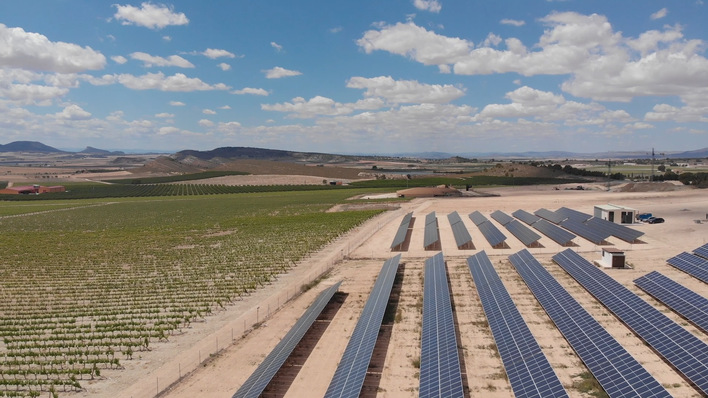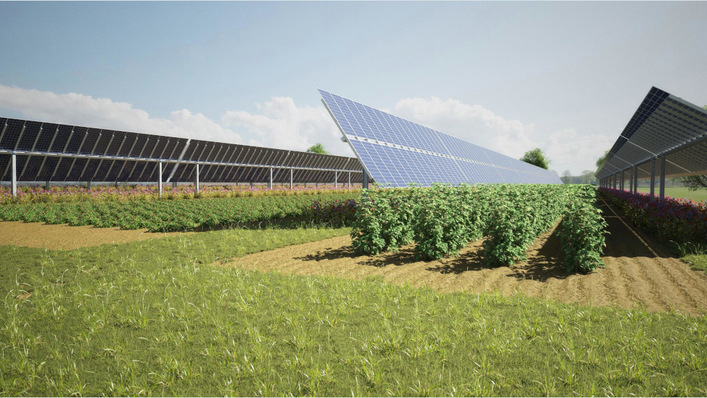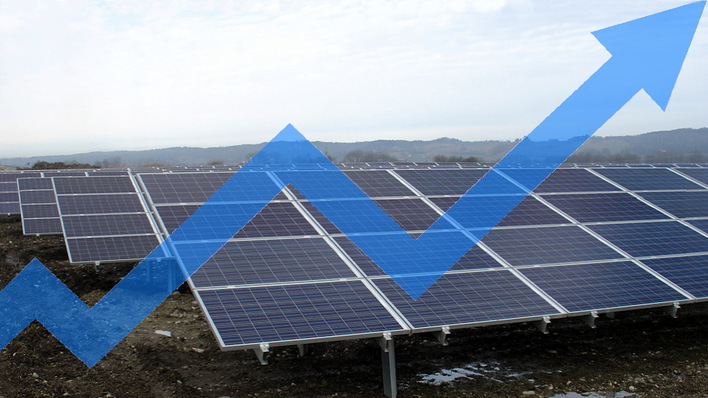How is the demand for agri-PV systems developing at Next2Sun?
Marius Sinn: We are noticing strong demand. In 2024, we built systems with a total output of almost 20 megawatts and a further 20 megawatts are currently under construction. The potential for 2025 is even greater.
What kinds of farmers are you working alongside? Are they more likely to be large agricultural companies or smaller farm businesses?
We actually work more with the smaller farms. Our project sizes range between two and six megawatts. Of course, we also have one or two larger projects every year. Many systems are realised as a result of our own project development, and as such we approach farmers in their capacity as landowners.
How are these projects financed?
In some cases, customers finance their projects independently. Next2Sun's own projects are usually financed by the triad of equity, citizen participation/crowdfunding and bank loans. Farmers often also invest in the projects personally.
How is this crowdfunding organised?
Next2Sun has its own investment platform. We also work together with the ecological financial services provider Grüne Sachwerte from Bremen. They have a great deal of experience in this field and can also carry out plausibility checks of projects to scrutinise them from the investors' point of view.
Next2Sun and partner build first vertical agri-PV system in the US
The Next2Sun system has been available for quite some time. What technical developments have you made since the system was launched?
We started developing the vertical photovoltaic system over ten years ago and founded Next2Sun in 2015. Since then, we have continuously developed the entire system in terms of shading, installation efficiency and use of materials. Our developments have extended to the module design, and this year our own optimised Next2Sun modules became available for the first time. One of our latest developments is the larger, three-row system for wider row spacing and working distances.
The higher the system gets, the higher the wind forces become. Could that become a problem at some point?
That was indeed a challenge for a long time. That's why we only built two rows for a very long time. But during the first trials with the three-row system, we realised that it works. Of course, the assembly then also becomes slightly more complex.
PV from field and barn: Our special for the dual harvest on farms
What is the height of the three-row systems?
The three-row system ranges in height from 4.2 to 5.0 metres, depending on the slope. If the slope is steeper, the system will be higher because the modules have to be horizontal. As a result, the element on the deep side is slightly higher.
What slopes can you cover?
We can build our standard system on slopes of up to 20 per cent. That's equivalent to more than ten degrees when positioned perpendicular to the slope. Special solutions are also conceivable for even greater inclinations. If the system is positioned horizontally to the slope, there are no limits, although shading is different in comparison to a system that is perpendicular.
Vertical agri-PV plant wins Austrian Solar Prize 2023
How does the shading change in this case?
If the system is parallel to the slope, it receives less light from the rear on the side facing up the slope. However, it gets more light at the front. That's why we need to choose another row spacing in this case. Perpendicularity to the slope is very interesting from a cultivation perspective, as farmers generally cultivate the land up the slope. Otherwise, soil erosion would increase.
How have you improved the shading problem within the system?
Recently, we have optimised both the module and the frame system to maximise light yield and minimise shading losses. This is what enables the above-average yields per kilowatt of the Next2Sun systems.
How flexible is the post-and-beam construction that constitutes the system, and how precise do the foundations have to be?
We offer various versions of our system to accommodate different terrain characteristics and row spacings. Both the size and the number of modules on top of each other can be varied. The foundation itself has to be precise in order to keep the distance between the posts as exact as possible.
Manufacturer Next2Sun signs cooperation agreements in India
What is the foundation for the posts?
As a rule, they are driven into the ground. The depth of the piles varies and depends on the project. Even within a project, we sometimes have different pile-driving depths, as we also have different wind loads within a system. These are higher at the edge than in the centre, and so we ram deeper at the edges than in the centre.
How much power do you get from an area with these different heights?
We usually get between 400 and 500 kilowatts per hectare.
And how does the height of the system affect the capacity? Is it the higher the system, the wider the distance between the rows?
If the system is higher, for example with the three-row system, the area power of the system also increases. The third module provides more shading and the module rows have to be placed wider apart. This is precisely why we developed the three-row system. In conventional farming, the row spacing is already typically wider. This enables us to construct higher without the risk of shading and thus achieve a better area coverage ratio.
What is the risk of the modules being damaged by falling stones when cultivating the area?
So far, stone chipping has hardly caused any problems. In the past, the modules were built at a distance of 60 centimetres from the ground. However, due to the regulatory requirements for agri-PV in most countries, the modules have to keep a minimum distance of 80 centimetres from the ground. This also reduces the risk of stones crashing even further.
What are the typical row spacings?
To ensure that the modules shade each other as little as possible, the minimum spacing with the two-row system is eight metres. We usually install at a distance of ten metres between rows. However, we can also realise larger spacings. In this case, we are guided by the requirements of the agricultural use of the land. Smaller row spacings are also possible, but we have to specifically check how this affects the yield. Certainly in regions with higher solar irradiation, you can take more chances and still operate the system economically.
You’ve now also developed a fence system for consumers.
Yes, the Next2Sun premium solar fence is an excellent alternative to conventional fencing. Thanks to its clear design in anthracite or galvanised, with visually appealing square posts in which the cables completely disappear, and in combination with the new module, the fence fits in perfectly with both modern architecture and traditional buildings. Of course, we also offer our standard system as a single or double-row fence. This can be used to fence in the agri-PV systems as well as other agricultural areas or commercial and industrial properties.
In that case, will you build the fence completely around the area, including the north side?
We have the north side in mind in any case. Because we always build our systems in the direction of agricultural cultivation. This is not always strictly east-west orientated. Otherwise, it would be awkward for the farmer if a solar power system was installed diagonally across his field. In that case, we wouldn't have the perfect yield curve. But that also has advantages. For example, the south-facing part of the system produces considerably more electricity in winter because it can better absorb the vertical rays and the flatter sun. In addition, there is no snow on the modules in winter and the yield is anyway much higher than with normal installations.
Unmanageable strips remain under the module rows. What effects do these strips have?
These are so-called old grass or biodiversity strips in which specific habitat structures can also be established, for example for small animals or beneficial insects. The strips typically have to be mown once a year.
What is the width of this strip?
It is usually one metre in width, 50 centimetres on each side. That's enough for the farmers to cultivate the area without conflicting with the solar system. This is because farmers generally use GPS, which is very precise. The machines are also designed to work very rigidly and not to swerve. After all, farmers are also used to driving relatively precisely when sowing to avoid large overlaps.
In these conditions, the vertically mounted modules are unable to be perfectly aligned with the sun. What yields can farmers expect?
With our systems with bifacial modules, we generally achieve even higher yields throughout the year than a solar park with monofacial modules, which is usually facing south. This is because the vertical systems have two daily production peaks when orientated east-west. The counter-cyclical generation profile not only significantly reduces the immediate need to expand storage and grid capacities, but also helps to achieve higher electricity market prices than at midday.
Interview by Sven Ullrich.








